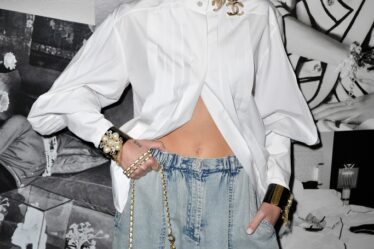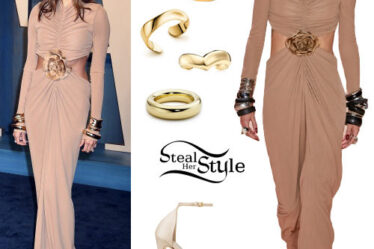
When Milk Makeup launched its Cooling Water Jelly Tint in February, with the tagline: “Colour so juicy, it’s almost good enough to eat,” the team expected it to create buzz online, said Dianna Ruth, Milk Makeup’s co-founder and head of product development.
They did not, however, anticipate that the lip and cheek stain, which features a jelly-like texture and cooling sensation when applied, to go as viral as it did on TikTok, with some creators taking that tagline to heart, by taking a literal bite out of the product.
“Can you blame me though? It looks like grape jelly and kool aid,” creator Hannah Cho said on TikTok. Videos about the product, which sold out twice on Sephora within two weeks and currently has a waitlist of over 45,000 shoppers, have racked up millions of views on the platform — Cho’s alone has 3 million.
Milk is just the latest brand to use food — especially sweet treats — to sell cosmetics. In 2023, several of the major beauty trends that emerged from TikTok were named after food. There was strawberry girl makeup (heavily pink eyes and cheeks); glazed doughnut nails (sheer with a lot of shimmer) and cinnamon cookie butter hair (brown with caramel and copper undertones), just to name a few.
The association between beauty and food can be traced all the way back to Ancient Egypt, when Cleopatra popularised kohl eyeliner, which counts burnt almonds as an ingredient. More recently, Lip Smackers’ fruit-flavoured lip glosses and balms were a staple for Millennial consumers in the aughts.
The trend’s most recent iteration is fuelled by increased engagement with food and beverage content on platforms like TikTok, with #FoodTikTok having amassed over 112 billion views. The platform’s foodie community is as much a driver of fleeting trends as is beauty and fashion. (Baked feta pasta and ‘sleepy girl’ mocktails are examples of trends that have gained virality on the app.) In response, beauty brands are launching products that resemble food — usually desserts — or are marketing their assortment alongside actual candy, like gummy bears and gum drops. To drive further conversation among Gen-Z shoppers, labels are partnering with food companies, like Rhode Skin’s team-up with Krispy Kreme and Too Faced’s collaboration with Pop-Tarts.
It’s not a fool-proof strategy: Beauty Bakerie, which structured their entire catalogue around products that looked like baked goods, including its Face Flour Baking Powder and Matte Lip Whips lipsticks, shuttered in April. The trick is to capitalise on food-centric trends without banking on them entirely.
“When ‘glazed doughnut’ was at its height, sales of highlighters ticked up as did dewy serums,” said Larissa Jensen, senior vice president and global beauty industry advisor at Circana. “It’s definitely working.”
Hopping on the Trend
TikTok, with its precise algorithm churning content at high speeds, has birthed beauty trends with very little staying power. In the span of six months, the platform had introduced the strawberry girl trend, characterised by a heavily blushed and freckled face, latte makeup which sports brown lip liner and heavy use of bronzer, as well as blueberry milk nail trend, characterised by a pale blue nail colour.
What these food-centric beauty trends, like latte makeup and blueberry milk nails, have in common is that they are more a reinvigoration and rebranding of makeup techniques that already exist, according to TikTok creator Mandy Lee, known online as “Old Loser In Brooklyn,” who breaks down trends on her account.
“A singular line of sameness can constitute a trend on TikTok,” she said. “Trends used to have subcultures attached to them and were rooted in a shared history.”
But tapping into the cultural moment — even if it’s fleeting — can generate buzz and sales, especially from Gen-Z and Gen Alpha shoppers for whom social media serves as their primary source of information when making makeup purchasing decisions, according to data from Circana.
What that means, however, is that the lift for brands to participate in these trends is much lighter — they only have to update the marketing of their existing catalogue to respond to the moment.
For lip care brand Lanolips, tapping into the glazed doughnut trend was as simple as introducing a glazed doughnut flavour of their 101 Ointment Multi-Balm, one of their hero products. The product quickly became a top SKU for the label, selling out in a month on its website.
“Food and beauty both have this sensorial experience, it’s almost like an indulgence in a way skincare isn’t,” said Kirsten Carriol, founder and chief executive of Lanolips. “The ointment is meant to hydrate the lips but that can get boring. Adding flavours has been a game changer for us and the flavoured ointment range now makes up 30 percent of our business.”
Even if a brand can’t update a current product, it can still highlight how their existing offering can be used to tap into a trend. For example, in 2023, sales for lip balm, a staple of the ‘glazed doughnut’ look, reached $285 million, an 85 percent jump from the previous year, according to data from Circana. And sales for blush, a must-have for consumers wanting to play around with the strawberry girl or tomato girl trends, peaked at $426 million, an increase of 60 percent year-over-year.
The Right Mix of Collaborators
For beauty brands who want to make a bigger bet on the food trend, product collaborations have proved to be an effective tool.
Hailey Bieber’s Rhode Skin, for instance, partnered with Krispy Kreme to create a strawberry flavoured version of the label’s best-selling peptide lip treatment. The collaboration increased engagement in Rhode’s social channels by 715 percent, according to retail analytics firm Trendalytics. Since then, Rhode has doubled down on food associations, launching tinted versions of the lip peptide treatment in shades like espresso, jelly bean and toast, with marketing to match.
For E.l.f Beauty, collaborations with food companies are a way for the business to access a new customer base that may not have necessarily heard of the brand, or encourage existing customers to engage with products they are familiar with in a new way, said Kory Marchisotto, E.l.f Beauty’s chief marketing officer.
In 2021, E.l.f. teamed up with fast-casual Mexican-inspired restaurant Chipotle on a makeup palette that resembled the restaurant’s assembly line of beans, rice and guacamole, and in April, it partnered with canned water brand Liquid Death on a collection of heavy metal-inspired makeup, including a black lipstick and heavy eyeliner.
“For any collaboration we do, we need to check the box that the brand is a challenger in its category, and the second box is humour,” said Marchisotto. “When I think about E.l.f and what our community is, they give us permission to be fun and funny.”
The fun factor is core to beauty’s embrace of food. Beyond driving sales, it’s a way for beauty brands to give their customers something lighthearted to talk about.
“In the 2010s, makeup became really serious. You had to contour and bake and add false lashes,” said Arionne Nettles, a Chicago, Illinois-based educator. “This trend feels like a return to a time when makeup felt fun and less intimidating.”
Sign up to The Business of Beauty newsletter, your complimentary, must-read source for the day’s most important beauty and wellness news and analysis.


